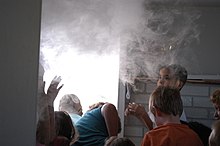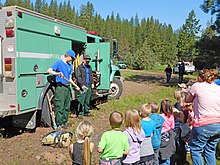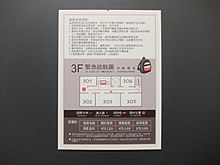What Is Considered Norm? Fire And Emergency Services Safety And Survival

Fire safe equipment at a construction site in China

Property loss acquired by arson.
Fire prophylactic is the set of practices intended to reduce the destruction acquired by burn down. Fire safety measures include those that are intended to prevent ignition of an uncontrolled fire, and those that are used to limit the development and effects of a burn down after information technology starts.
Fire safety measures include those that are planned during the construction of a edifice or implemented in structures that are already standing, and those that are taught to occupants of the building.
Threats to fire safety are commonly referred to as fire hazards. A burn down chance may include a state of affairs that increases the likelihood of a fire or may impede escape in the result a fire occurs.
Fire safety is often a component of edifice safety. Those who inspect buildings for violations of the Burn down Code and go into schools to educate children on burn down safe topics are fire department members known as Burn Prevention Officers. The Primary Burn Prevention Officer or Chief of Fire Prevention will normally train newcomers to the Burn Prevention Division and may too conduct inspections or make presentations.[one]
Elements of a fire safety policy [edit]

External fire escape stairs in a public building in Netherlands.
Burn down prophylactic policies apply at the construction of a building and throughout its operating life. Building codes are enacted past local, sub-national, or national governments to ensure such features as adequate burn exits, signage, and construction details such as fire stops and fire rated doors, windows, and walls. Fire safety is also an objective of electrical codes to prevent overheating of wiring or equipment, and to protect from ignition by electric faults.[2]
Burn codes regulate such requirements as the maximum occupancy for buildings such as theatres or restaurants, for instance. Fire codes may require portable burn extinguishers within a building, or may require permanently installed fire detection and suppression equipment such equally a fire sprinkler organization and a fire alarm system.
Local regime charged with fire rubber may conduct regular inspections for such items every bit usable burn down exit and proper get out signage, functional fire extinguishers of the right type in accessible places, and proper storage and handling of combustible materials. Depending on local regulations, a fire inspection may result in a discover of required activeness, or closing of a edifice until information technology can exist put into compliance with fire code requirements.
Owners and managers of a building may implement boosted fire policies. For instance, an industrial site may designate and train particular employees as a fire fighting force. Managers must ensure buildings comply with burn down evacuation regulations, and that building features such equally spray fireproofing remains undamaged. Fire policies may be in place to dictate training and awareness of occupants and users of the building to avert obvious mistakes, such as the propping open up of fire doors. Buildings, especially institutions such as schools, may conduct burn down drills at regular intervals throughout the year.
Common fire hazards [edit]

Improper apply and poor maintenance of gas stoves often create fire hazards.
Some common fire hazards are:[3]
- Kitchen fires from unattended cooking, grease fires/chip pan fires
- Electrical systems that are overloaded, poorly maintained or defective
- Flammable storage areas with insufficient protection
- Combustibles near equipment that generates heat, flame, or sparks
- Candles and other open flames
- Smoking (Cigarettes, cigars, pipes, lighters, etc.)
- Equipment that generates heat and utilizes flammable materials
- Flammable liquids and aerosols
- Flammable solvents (and rags soaked with solvent) placed in enclosed trash cans
- Fireplace chimneys not properly or regularly cleaned
- Cooking appliances - stoves, ovens
- Heating appliances - fireplaces, wood-burning stoves, furnaces, boilers, portable heaters, solid fuels
- Household appliances - clothes dryers, crimper irons, hair dryers, refrigerators, freezers, boilers
- Chimneys that concentrate creosote
- Electrical wiring in poor status
- Leaking/ defective batteries
- Personal ignition sources - matches, lighters
- Electronic and electrical equipment
- Exterior cooking equipment - charcoal-broil
Fire code [edit]

An example of a fire code violation in the U.s.
In the U.s., the burn down code (also burn prevention code or fire prophylactic lawmaking) is a model code adopted by the state or local jurisdiction and enforced by fire prevention officers inside municipal burn departments. It is a ready of rules prescribing minimum requirements to prevent fire and explosion hazards arising from storage, treatment, or use of dangerous materials, or from other specific hazardous conditions.[4] It complements the building code. The burn code is aimed primarily at preventing fires, ensuring that necessary preparation and equipment will be on hand, and that the original design basis of the building, including the basic programme set out by the architect, is not compromised. The fire code besides addresses inspection and maintenance requirements of various fire protection equipment in order to maintain optimal active fire protection and passive burn down protection measures.
A typical fire condom code includes administrative sections about the rule-making and enforcement process, and noun sections dealing with fire suppression equipment, item hazards such as containers and transportation for combustible materials, and specific rules for hazardous occupancies, industrial processes, and exhibitions.
Sections may establish the requirements for obtaining permits and specific precautions required to remain in compliance with a let. For example, a fireworks exhibition may require an application to be filed by a licensed pyrotechnician, providing the information necessary for the issuing authority to determine whether safety requirements tin can be met. In one case a let is issued, the same authority (or another delegated authority) may inspect the site and monitor prophylactic during the exhibition, with the power to halt operations, when unapproved practices are seen or when unforeseen hazards arise.
List of some typical burn and explosion issues in a fire code [edit]
- Fireworks, explosives, mortars and cannons, model rockets (licenses for manufacture, storage, transportation, sale, use)
- Certification for servicing, placement, and inspecting fire extinguishing equipment
- General storage and handling of flammable liquids, solids, gases (tanks, personnel training, markings, equipment)
- Limitations on locations and quantities of flammables (e.g., 10 liters of gasoline inside a residential dwelling)
- Specific uses and specific flammables (e.one thousand., dry out cleaning, gasoline distribution, explosive dusts, pesticides, space heaters, plastics manufacturing)
- Permits and limitations in various building occupancies (assembly hall, infirmary, school, theater, elderly care, child intendance centers) that require a fume detector, sprinkler arrangement, fire extinguisher, or other specific equipment or procedures
- Removal of interior and exterior obstructions to emergency exits or firefighters and removal of hazardous materials
- Permits and limitations in special outdoor applications (tents, asphalt kettles, bonfires, etc.)
- Other hazards (flammable decorations, welding, smoking, majority matches, tire yards)
- Electrical safety codes such as the National Electric Code (by the National Fire Protection Association) for the U.S. and some other places in the Americas
- Fuel gas code
- Car burn
Public burn safety education [edit]

Children evacuating a smoky building equally a way to learn fire safety

Most U.S. fire departments have burn safety education programs.
Fire prevention programs may include distribution of smoke detectors, visiting schools to review key topics with the students and implementing nationally recognized programs such equally NFPAS "Risk Watch" and "Learn not to burn down".[v]
Other programs or props tin be purchased by fire departments or community organizations. These are ordinarily entertaining and designed to capture children'south attention and relay important messages. Props include those that are mostly auditory, such equally puppets and robots. The prop is visually stimulating but the condom bulletin is simply transmitted orally. Other props are more elaborate, admission more than senses and increase the learning factor. They mix sound messages and visual cues with easily-on interaction. Examples of these include mobile trailer safety houses and tabletop hazard business firm simulators. Some burn down prevention software is also being developed to place hazards in a dwelling.[six]
All programs tend to mix messages of general injury prevention, safe, burn down prevention, and escape in instance of fire. In most cases the fire section representative is regarded equally the practiced and is expected to nowadays information in a manner that is appropriate for each historic period group.
Fire educator qualifications [edit]
The Usa industry standard that outlines the recommended qualifications for fire prophylactic educators is NFPA 1035: Standard for Professional Qualifications for Public Fire and Life Safe Educator, which includes the requirements for Burn down and Life Prophylactic Educator Levels I, II, and III; Public Information Officer; and Juvenile Firesetter Intervention Specialist Levels I and II.[7]
Target audiences [edit]
According to the United States Burn down Administration, the very young and the elderly are considered to exist "at risk" populations. These groups represent approximately 33% of the population.
Global perspectives [edit]
Fire safe has been highlighted in relation to global supply chain management. Sedex, the Supplier Upstanding Data Exchange, a collaborative platform for sharing upstanding supply concatenation information,[8] and Verité, Inc., a Massachusetts-based supply concatenation investigatory NGO, issued a briefing in August 2013 which highlighted the significance of this outcome.[ix] The conference referred to several major factory fires, including the 2012 Dhaka garment factory fire in the Tazreen Way factory and other examples of fires in Bangladesh, Pakistan[10] and elsewhere, compared the incidence of fire safety issues in a manufacturing context, and highlighted the need for buyers, suppliers and local burn down safe enforcement agencies all to take activity to amend burn safety within the supply bondage for set up-made garments and other products. The briefing recommended that buyers seek greater visibility of fire safety and other risks across the supply concatenation and place opportunities to better standards: "buyers can encourage modify through more than responsible and consistent practies".[9]
Burn safety plan [edit]

Fire escape plan of a hotel in Taiwan.
A burn down safe program is required by all North American national, state and provincial fire codes based on edifice use or occupancy types. By and large, the owner of the edifice is responsible for the preparation of a burn prophylactic plan. Buildings with elaborate emergency systems may require the aid of a burn down protection consultant. Later the program has been prepared, it must be submitted to the Chief Fire Official or potency having jurisdiction for approval. Once approved, the owner is responsible for implementing the burn down condom plan and grooming all staff in their duties. Information technology is also the owner's responsibility to ensure that all visitors and staff are informed of what to exercise in example of fire. During a fire emergency, a copy of the approved fire rubber program must be available for the responding burn department's employ.
In the United Kingdom, a fire safety plan is called a fire risk assessment.[11]
Fire safety plan structure [edit]
- Key contact information
- Utility services (Including shut-off valves for water, gas and electric)
- Admission bug
- Dangerous stored materials
- Location of people with special needs
- Connections to sprinkler organisation
- Layout, drawing, and site plan of building
- Maintenance schedules for life safety systems
- Personnel training and fire drill procedure
- Create assemble point/safe zone
Utilise of burn down safety plans [edit]
Burn prophylactic plans are a useful tool for burn fighters to have considering they allow them to know critical information about a building that they may accept to get into. Using this, fire fighters can locate and avoid potential dangers such equally hazardous material (hazmat) storage areas and combustible chemicals. In improver to this, burn down safety plans can also provide specialized information that, in the example of a infirmary burn down, can provide data well-nigh the location of things like the nuclear medicine ward.[12] In addition to this, burn down safety plans likewise greatly improve the safety of burn down fighters. According to FEMA, 16 per centum of all firewoman deaths in 2002 occurred due to a structural collapse or because the fire fighter got lost.[13] Burn down prophylactic plans can outline whatsoever possible structural hazards, too every bit requite the fire-eater knowledge of where he is in the edifice.
Fire safe plans in the burn code [edit]
In North America alone, there are around eight one thousand thousand buildings that legally require a fire safety plan, be it due to provincial or land law.[14] Non having a burn down condom plan for buildings which fit the fire code occupancy type can result in a fine, and they are required for all buildings, such as commercial, industrial, assembly, etc.
Advances in fire prophylactic planning [edit]
As previously stated, a copy of the approved fire safety program shall exist available for the responding fire department. This, however, is not ever the case. Up until now, all fire plans were stored in paper form in the fire department. The problem with this is that sorting and storing these plans is a challenge, and it is difficult for people to update their burn down plans. Equally a result, merely one-half of the required buildings accept burn down plans, and of those, only around 10 percent are upwards-to-date.[14] This problem has been solved through the introduction of digital fire plans. These fire plans are stored in a database and can be accessed wirelessly on site by firefighters and are much simpler for edifice owners to update.
Insurance companies [edit]
Fire is one of the biggest threats to holding with losses adding upwardly to billions of dollars in amercement every year. In 2019 lone, the total corporeality of belongings damage resulting from fire was $xiv.8 billion in the United States.[xv] Insurance companies in the United States are non only responsible for financially covering burn down loss but are also responsible for managing risk associated with information technology. Virtually commercial insurance companies hire a risk control specialist whose primary chore is to survey property to ensure compliance with NFPA standards, assess the current risk level of the property, and make recommendations to reduce the probability of burn loss. Careers in belongings risk management go along to grow and have been projected to grow 4 to 8% from 2018 to 2028 in the Usa.[16]
Encounter also [edit]
- Ablation – Removal of material from an object'southward surface by erosion
- Edifice information modeling – Process used to design and document building and infrastructure designs
- Emergency evacuation – Urgent removal of people from an area of imminent or ongoing threat
- Endothermic process – Concrete process that takes up estrus (or electrical energy) from surroundings
- Burn Equipment Manufacturers' Clan
- Burn down drill – Method of practicing orderly evacuation in instance of a burn
- Fire sprinkler – Component that discharges water to protect buildings
- Fire-adapted communities
- Firestop pillow
- Firework Code
- Intumescent
- List of fires
- Listing and approval use and compliance
- Product certification
- Condom Centre
References [edit]
- ^ lifesafetydev. "Fire Safety". Life Safety Systems . Retrieved 2020-11-12 .
- ^ "Planning , Drawing & Designing". matrixfireengineers.com . Retrieved 2020-11-12 .
- ^ "Fire Safety". Fire Protection Specialists. Archived from the original on 19 Jan 2014. Retrieved 17 January 2014.
- ^ "Manufactures - Fire Lawmaking | Safety Media Inc". safetymedia.com . Retrieved 2020-11-12 .
- ^ NFPA eLearning On-line catalog
- ^ "September 2011". Magazine . Retrieved 2020-xi-06 .
- ^ "Buy NFPA 1035: Standard on Fire and Life Safe Educator, Public Information Officeholder..." catalog.nfpa.org . Retrieved 2020-11-12 .
- ^ BSI, Supplier Ethical Data Exchange (Sedex), accessed 28 May 2022
- ^ a b Sedex Information Exchange, Fire Safety conference, Baronial 2013, accessed 28 May 2022
- ^ Zia ur-Rehman, Declan Walsh and Salman Masood, More than 300 Killed in Pakistani Manufactory Fires, New York Times, published 12 September 2012, accessed 28 May 2022
- ^ "Burn condom in the workplace". GOV.UK . Retrieved 21 August 2021.
- ^ American, Jerry, "Fire Safety Disaster", Canadian Healthcare Facilities Volume 28 Issue 3, ed Amie Silverwood. Spring 2008, 26.
- ^ Fire Fighter Fatalities in the U.Southward. in 2002. Fema, U.S. Department of Homeland Security, July 2003
- ^ a b "Canadian firm generates digital burn safety plans", Building Strategies, ed. Susan Maclean. Spring 2007, 14
- ^ "NFPA report - Burn loss in the United States". www.nfpa.org . Retrieved 2020-x-21 .
- ^ "13-2099.02 - Risk Direction Specialists". www.onetonline.org . Retrieved 2020-10-22 .
External links [edit]
- Sample Fire Code Tabular array of Contents from International Code Council
What Is Considered Norm? Fire And Emergency Services Safety And Survival,
Source: https://en.wikipedia.org/wiki/Fire_safety
Posted by: fergusonsuffect.blogspot.com


0 Response to "What Is Considered Norm? Fire And Emergency Services Safety And Survival"
Post a Comment